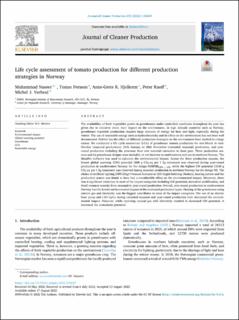| dc.contributor.author | Naseer, Muhammad | |
| dc.contributor.author | Persson, Tomas | |
| dc.contributor.author | Hjelkrem, Anne-Grete Roer | |
| dc.contributor.author | Ruoff, Peter | |
| dc.contributor.author | Verheul, Michel | |
| dc.date.accessioned | 2023-03-29T14:04:13Z | |
| dc.date.available | 2023-03-29T14:04:13Z | |
| dc.date.created | 2022-10-25T16:46:40Z | |
| dc.date.issued | 2022 | |
| dc.identifier.citation | Naseer, M., Persson, T., Hjelkrem, A. G. R., Ruoff, P., & Verheul, M. J. (2022). Life cycle assessment of tomato production for different production strategies in Norway. Journal of Cleaner Production, 372, 133659. | en_US |
| dc.identifier.issn | 0959-6526 | |
| dc.identifier.uri | https://hdl.handle.net/11250/3060980 | |
| dc.description.abstract | The availability of fresh vegetables grown in greenhouses under controlled conditions throughout the year has given rise to concerns about their impact on the environment. In high latitude countries such as Norway, greenhouse vegetable production requires large amounts of energy for heat and light, especially during the winter. The use of renewable energy such as hydroelectricity and its effect on the environment has not been well documented. Neither has the effect of different production strategies on the environment been studied to a large extent. We conducted a life cycle assessment (LCA) of greenhouse tomato production for mid-March to mid-October (seasonal production), 20th January to 20th November (extended seasonal) production, and year-round production including the processes from raw material extraction to farm gate. Three production seasons and six greenhouse designs were included, at one location in southwestern and one in northern Norway. The SimaPro software was used to calculate the environmental impact. Across the three production seasons, the lowest global warming (GW) potential (600 g CO2-eq per 1 kg tomatoes) was observed during year-round production in southwestern Norway for the design NDSFMLLED + LED, while the highest GW potential (3100 g CO2-eq per 1 kg tomatoes) was observed during seasonal production in northern Norway for the design NS. The choice of artificial lighting (HPS (High Pressure Sodium) or LED (Light Emitting Diodes)), heating system and the production season was found to have had a considerable effect on the environmental impact. Moreover, there was a significant reduction in most of the impact categories including GW potential, terrestrial acidification, and fossil resource scarcity from seasonal to year-round production. Overall, year-round production in southwestern Norway had the lowest environmental impact of the evaluated production types. Heating of the greenhouse using natural gas and electricity was the biggest contributor to most of the impact categories. The use of an electric heat pump and LED lights during extended seasonal and year-round production both decreased the environmental impact. However, while replacing natural gas with electricity resulted in decreased GW potential, it increased the ecotoxicity potential. | en_US |
| dc.language.iso | eng | en_US |
| dc.publisher | Elsevier | en_US |
| dc.rights | Navngivelse 4.0 Internasjonal | * |
| dc.rights.uri | http://creativecommons.org/licenses/by/4.0/deed.no | * |
| dc.title | Life cycle assessment of tomato production for different production strategies in Norway | en_US |
| dc.type | Peer reviewed | en_US |
| dc.type | Journal article | en_US |
| dc.description.version | publishedVersion | en_US |
| dc.rights.holder | The authors | en_US |
| dc.subject.nsi | VDP::Landbruks- og Fiskerifag: 900 | en_US |
| dc.source.pagenumber | 1-10 | en_US |
| dc.source.volume | 372 | en_US |
| dc.source.journal | Journal of Cleaner Production | en_US |
| dc.identifier.doi | 10.1016/j.jclepro.2022.133659 | |
| dc.identifier.cristin | 2064964 | |
| cristin.ispublished | true | |
| cristin.fulltext | original | |
| cristin.qualitycode | 2 | |

